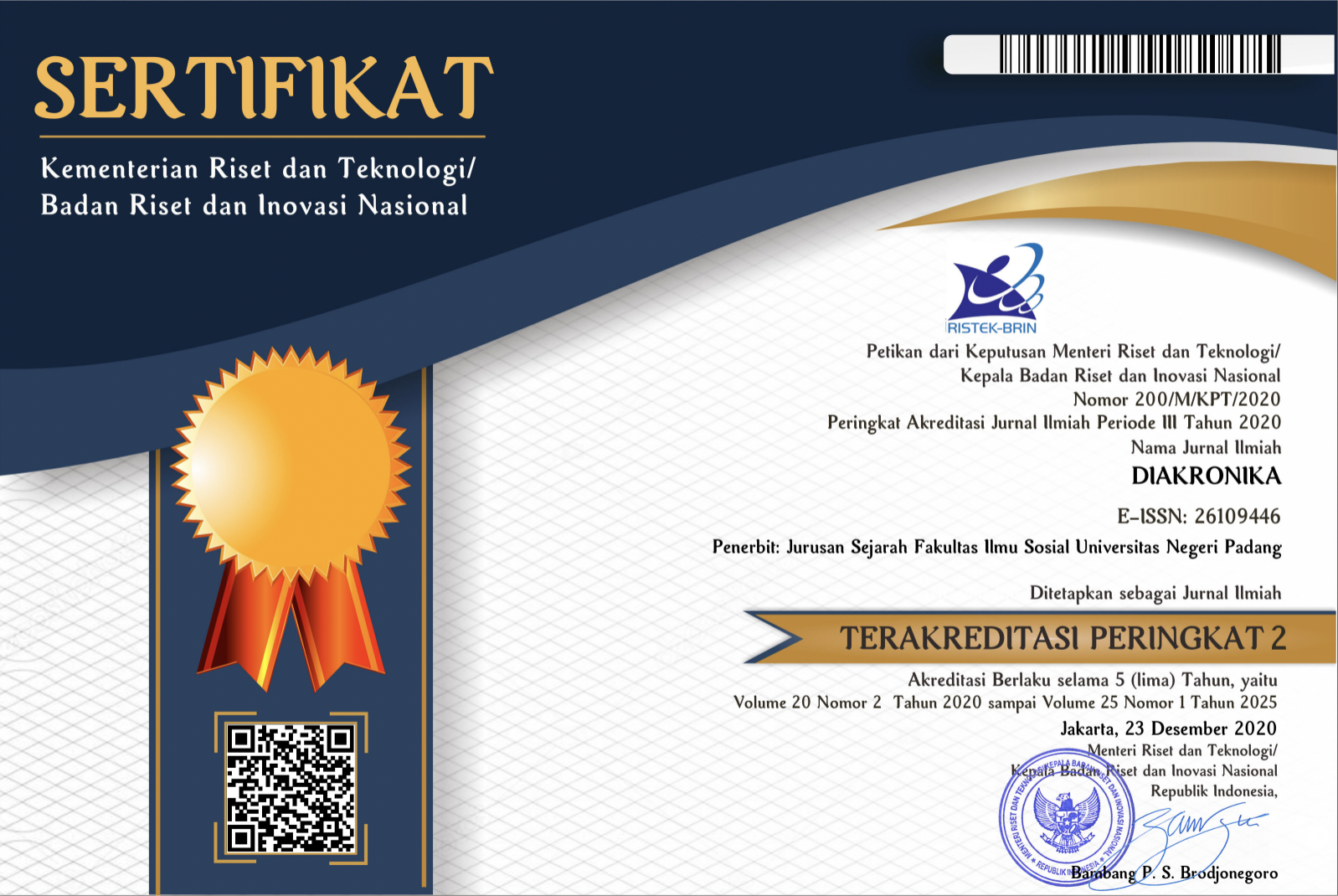Death Kongsi and the Survival of Chinese Death Processions in Padang City
Abstract
This article explains how the ethnic Chinese of Padang maintain the continuity of the death procession in Chinese culture. This article uses a historical approach by utilizing sources in the form of Dutch period documents, organizational documents of Himpunan Tjinta Teman (HTT) and Himpunan Bersatu Teguh (HBT), newspaper news and literature studies on the death processions of ethnic Chinese in Indonesia and outside Indonesia, as well as observations and interviews with HBT and HTT funeral administrators. These sources are used to find facts related to the death processions carried out by ethnic Chinese and the existence of HBT and HTT as institutions organizing Padang Chinese funeral processions. Furthermore, the existing facts are analyzed using historical and ethnographic approaches. The findings of the article show that the ethnic Chinese of Padang still carry out and preserve the implementation of the Chinese cultural death procession in an organizational forum. In this case, the organization's function as the organizer of the death procession for Padang Chinese is the key to the survival and existence of the organization itself. Various Chinese cultures preserved and inherited in the HTT and HBT organizations, including the culture of death, are essential in forming self- and collective identity and solidarity of Chinese community groups in the city of Padang.
Downloads
References
Aufa, A. A. (2017). Memaknai Kematian Dalam Upacara Kematian Di Jawa. An-Nas, 1(1), 1–11. https://doi.org/10.36840/an-nas.v1i1.164
Beaver, S. . (1994). Netherlands East Indies Volume 2. Naval Intelligence.
Berkson, M. (2019). Death in Ancient Chinese Thought:What Confucians and Daoists Can Teach Us About Living and Dying Well. https://doi.org/https://doi.org/10.1007/978-3-030-19300-3_2
Cabgianto, A. (2015). Pandangan Filosofi Tionghoa Memandang Mati Bagaikan Hidup.
Chee-Kiong,T.(2004).Chinese Death Rituals In Singapore. Routledge. https://doi.org/https://doi.org/10.4324/9780203493663
Cheng, Y.(2005). New Paradigm for Re-engineering Education : Globalization, Localization and Individualization. Springer.
Dhavamony, M. (1995). Fenomologi Agama. Kanisius.
Dobbin, C. (2008). Gejolak Ekonomi, Kebangkitan Islam, dan Gerakan Paderi Minangkabau 1784-1847. Komunitas Bambu.
Du Puy, W. (1893). Encyclopaedia Britannica : a Dictionary of Art, Science and General Literature, Volume 22. Werner Co.
Erniwati, E. (2007). Asap Hio di Ranah Minang:Komunitas Tionghoa di Sumatera Barat. Ombak.
Erniwati, E. (2016). 140 Tahun Heng Beng Tong:Sejarah Perkumpulan Tionghoa 1876-2016. Komunitas Bambu.
Erniwati, E. (2019). Identitas Etnis Tionghoa Padang Masa Pemerintah Hindia Belanda. Patanjala : Jurnal Penelitian Sejarah Dan Budaya, 11(2), 185. https://doi.org/10.30959/patanjala.v11i2.482
Hasana, F., & Erniwati, E. (2023). Dari Pemakaman Ke Kremasi : Perubahan Prosesi Kematian Tionghoa Padang 2001-2022. Jurnal Kronologi, 5(2), 299–315. https://doi.org/10.24036/jk.v5i2.714
Hsu, C. Y., O’Connor, M., & Lee, S. (2009). Understandings of Death and Dying for People of Chinese Origin. Death Studies, 33(2), 153–174. https://doi.org/https://doi.org/10.1080/07481180802440431
Interview, L. (2022). No Title.
Interview Tin Soci, L. (2022).
Interview,M. (2023).
Kipnis, A. . (2019). Funerals and Religious Modernity in China. Review of Religion and Chinese Society, 6(2), 253–272. https://doi.org/https://doi.org/10.1163/22143955-00602006
Koentjaraningrat. (1985). Ritus Peralihan di Indonesia. Balai Pustaka.
Koentjaraningrat. (1987). Sejarah Teori Antropologi I. Universitas Indonesia.
Kuntowijoyo. (2003). Metodologi Sejarah Edisi Kedua. PT Tiara Wacana.
Makmur, M. (2016). The Funeral Business: The Business and Economic Activity of the Chinese Clan Associations in Medan. academia.edu. https://www.academia.edu/download/70302225/199d99aed2afa2b7c38afc0bf8a426235705.pdf
Nakayama, T., & Martin, J. (2010). Antarbudaya Komunikasi Dalam Konteks Edisi Kelima. The McGraw Hill Company.
Rummens, J. (1993). Personal Identity and Social Structure in Sint Maartin. Saint Martin: A Plural.
Salmon, C. (2016). From Cemeteries to Luxurious Memorial Parks. With Special Reference to Malaysia and Indonesia. Archipel. Études Interdisciplinaires Sur Lehttps://journals.openedition.org/archipel/320
Sankar, L. V, Neo, D.H.J.(2016). Chinese culture and customs in Peranakan funerals in Malaysia and Singapore: https://fslmjournals.taylors.edu.my/wp-content/uploads/SEARCH/SEARCH-2016-8-1/SEARCH-2016-P2-8-1.pdf
Staatsblad, (1895).
Staatsblad, (1917).
Vleming, J. (1992). The Chinese Business Community in Netherlands India. In M. . Fernando (Ed.), Chinese Economic Activity in Netherlands India : Selected Translation from the Dutch. Institute of Southeast Asia Studies.
Young, K. . (1988). Sistem Tanam Paksa di Sumatera Barat: Stagnasi Ekonomi dan Jalan Buntu Dalam Politik.In A.Booth (Sejarah Ek). LP3ES.





